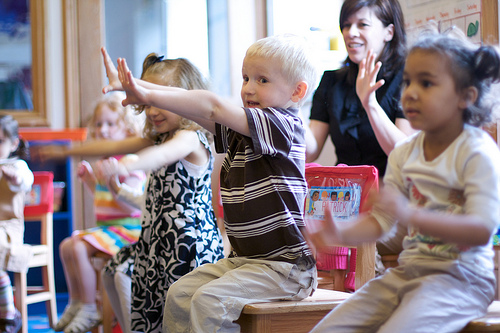
My first day teaching a class of kindergarteners many years ago started with me greeting the students one by one at the classroom door. When I turned around after greeting the final student in line, I discovered that, before the lesson had even started, I’d lost all control. With my back turned for a minute, the children’s nervous energy had them running around the room, screaming, and tearing apart the foam tile ABC carpet I had laid down for a story time area. My pleas for calm had no effect. For the children, all they knew was that a big strange man was saying some odd words (loudly) in a language they didn’t understand.
Needing a minute to think, I walked over to the CD player and, not knowing which song was first on the children’s music CD I had ready to go, pressed play. I was rescued that day by a song. An old classic clean up song started playing, and I started simply picking up the foam tiles as I sang along.
Midway through the song I noticed the children had joined me in tidying up, and some were singing along, too. By the end of the song, the classroom was clean, the children were quiet, and they were all looking up at me with an expression on their faces that said, “What’s next?” We had a good lesson, and songs have been an integral part of my classes ever since.
The benefits of songs as teaching tools go well beyond just teaching the language. Here are a few reasons to implement songs in your lessons from start to finish.
Songs create a positive atmosphere.
Just as we take great care in decorating our classrooms to make them warm and conducive to learning, we should think about how we are decorating our classrooms with audio. Learning a foreign language can be stressful for anyone, especially young learners. Fun, simple English songs playing as students enter the classroom help create a welcoming environment.
Songs help to balance energy levels.
Some children come to class bouncing off the walls, while others are quite reserved. Starting class with an active song allows the higher energy students to “get the wiggles out” and the lower energy students to pep up a little.
Songs are very effective in signaling transitions.
Students often get confused, and subsequently tune out, during transitions from one activity to another. Verbal directions alone can be difficult to understand, especially when a student was focusing on different activity. Using songs to signal changes helps students understand what is going on (and helps save the teacher’s voice, too!). Try using different songs to signal when it is time to start class, time to clean up, time to make a circle, time to take out your coursebook, etc.
Songs allow everyone to participate.
These days, some students come to our classes having learned English from birth, while others in the same class may be learning English for the first time. Singing is an activity that children of all levels can enjoy equally. Students with low English levels will be able to follow along with gestures and dances as they gradually learn the language in the song. More advanced students can also enjoy singing and dancing while improving their rhythm, intonation, and pronunciation, even if they already know all the words.
Songs allow for quick review.
It can sometimes be difficult to provide as much review as we’d like for our students. Songs are a fun, easy way to quickly re-introduce language from earlier lessons.
Songs are ‘sticky’.
When you teach with songs, you be assured those songs will bounce around your students heads long after the class is over. The same can’t be said for most other teaching tools.
A classroom full of songs is a warm classroom where students are getting lots of quality English input in a fun and easy-to-understand way. Are you using songs enough in your classes? What are some of your favorite ways to use songs in the classroom?